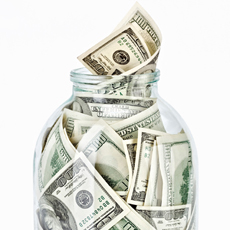Smart Savings

Five Tips to Financially Prepare for Parenthood
If you are thinking about expanding your family, there’s no better time than now to start saving. From healthcare expenses to unpaid time off work to shopping for all the necessities, a new baby will bring a variety of new expenses into your life. The following suggestions will help you to successfully work out the financial details of this joyous life change.
- Start saving now: When possible, it’s best to prepare for the added cost of parenthood ahead of time. The average yearly cost of a new baby is $12,940, according to the USDA. Estimate expenses and then try to save that much each month in the months leading up to the birth. Additionally, you should consider open a savings account for baby. You should always make sure your own emergency savings fund and retirement accounts are taken care of, but it’s important to pay into your baby’s savings account every month once you’ve established your budget to help with future expenses, including a college education. First National offers savings accounts with competitive interest rates to help you save even more.
- Explore employer and insurance benefits: Research the amount of leave your employer offers, and what portion will be paid. Determine if you will need to save ahead of time to make up for any lost wages during maternity or paternity leave. Also, review your insurance plan’s maternity and childcare benefits, and begin saving now for any out-of-pocket costs.
- Save on out-of-pocket expenses: There are plenty of ways to save money after you bring home your baby. Create a registry so your family and friends can help out with the big purchases such as car seats, strollers and cribs. Consider using cloth diapers or buying generic brands, instead of name-brand disposables. Try breast-feeding to avoid the high cost of formula, or buy formula in bulk at warehouse stores. Shop at secondhand stores and frequent garage sales for clothing and toys.
- Re-evaluate your life insurance policy: Update your life insurance policy to account for your newborn to help ensure that if you die, your family will be able to pay for life’s basic necessities, as well as future expenses such as your child’s college education.
- Create or modify your will: Every parent should have a will to ensure your child is cared for by the people you choose if anything should happen to you. Through your will, you are able to designate a guardian to care for your child and to serve as a trustee for any money your child will be slated to receive in adulthood.
Holiday Shopping Survival Tips

The holidays are a time for holiday cheer, but getting into the holiday giving spirit doesn’t mean you have to take on additional debt and anxiety while finding the perfect gifts for your friends and family. The following tips will help you prepare for the holidays while sticking to your budget and enjoying a stress-free holiday season.
- Set a Budget: Set a budget and make a shopping list ahead of time. Deciding how much you can afford to spend upfront and tracking your expenses along the way will help ensure you don’t go overboard financially. If you don’t have a plan, you are much more likely to make impulse purchases and spend more than you can afford.
- Start Early: Earlier is usually better when it comes to shopping for the holidays. Not only does it allow you to spend more time finding meaningful gifts for your loved ones, but it can help you save by spreading out your gift budget over a longer period of time, instead of spending a large amount during just one month.
- Comparison Shop: Use the power of the Internet to find the best deals. There are a variety of shopping apps available that take the stress out of comparison shopping and allow you to compare both online and brick and mortar store products and prices.
- Support Local Businesses: Support small businesses in your neighborhood and save gas, time and stress while finding unique and unexpected gifts that you may not find anywhere else.
- Schedule Your Shopping Trips: Avoid shopping malls on weekends and shop early or late in the day during the week. Not only will this save you time, but smaller crowds will mean you can have more freedom and space to shop around and find the best deal.
- Watch for Free Shipping: When online shopping, sign-up for emails from your favorite sites and keep your eye out for free shipping to get additional bang for your buck.
- Get Creative: Instead of buying a gift for each one of your friends and family members, find low-cost ways to give. The gift of food is always appreciated. Or consider partaking in a holiday gift exchange and draw names to only buy one gift for one person.
- Start Saving for Next Year: Open a First National Bank savings account to start saving for next year’s holiday season. Saving just a small amount each month can make a huge difference and ease the stress for next year.
Health Savings Accounts: What's Covered?

With the rising costs of healthcare, Health Savings Accounts (HSAs) are becoming more popular each year and can be a smart way for you to plan for future healthcare costs. These savings accounts are a great way for individuals covered under a high-deductible health plan to set aside pre-tax money to be used for qualified medical expenses. From co-payments to pharmacy bills to a new pair of glasses, consider the following factors to use tax-free dollars to supplement what is already covered by your medical insurance.
Benefits of Health Savings Accounts
HSAs offer many financial benefits, according to IRS.gov, and are a simple and flexible way for you to cover many common medical expenses.
- Earn interest, tax-free: Contributions to your HSA are made pre-tax, and you will not be taxed when you withdraw funds to pay for qualified medical expenses.
- Contributions remain in your account until you use them: Unlike other medical savings plans including Flexible Savings Accounts where you ‘use it or lose it’ by the end of the year, contributions to your HSA will remain in your account until you withdraw them.
- Keep your savings if you leave your job: HSAs are portable and stay with you if you change employers or leave the workforce.
- Ability to claim a tax deduction for contributions: You can claim a tax deduction for contributions that you make to your HSA, even if you don’t itemize your deductions on Form 1040.
- Opportunity to receive employer HSA contributions: Some employers contribute to HSAs and these contributions may be excluded from your gross income.
Eligible Expenses
Below are just some of the most common eligible medical expenses that can be paid for with your HSA. For a full list of eligible medical expenses, visit IRS.gov.
- Insurance Co-Pays and Doctor’s Fees
- Prescription Drugs
- Vision Care (including eye examinations, glasses and lenses, contacts, saline solution and cleaner and laser eye surgery)
- Dental Care (including X-rays, cleanings, fillings, extractions, dentures and orthodontics)
- Alcohol and Drug Addiction Treatment
- Home Care, Nursing Homes and Nursing Services
- Chiropractor Fees
- Therapy or Counseling (including alcoholism or drug addiction treatment)
- Fertility Treatment (including in vitro fertilization)
Contribution Limits
| Calendar Year 2014 | Calendar Year 2015 | |||
|---|---|---|---|---|
| Self Only | Family | Self Only | Family | |
| Annual HSA Contribution | $3,300 | $6,550 | $3,350 | $6,650 |
| HDHP Minimum Deductible | $1,250 | $2,500 | $1,300 | $2,600 |
| HDHP Out-Of-Pocket Limit (includes deductibles, co-payments, and other amounts but not premiums) | $6,350 | $12,700 | $6,450 | $12,900 |
| Catch Up Contribution Limits | $1,000 | $1,000 | ||
Our ${brands.bankShortName} Health Savings Account features no setup fee, no minimum daily balance, free checks, as well as the ability to pay with a Health Savings Visa® Debit Card. Learn More.
Ways to Save on Your Summer Travel

Summer vacation is just around the corner. From dining tips to the best online deal sites to finding the best place to stay, use the following tips to help you save while traveling with your family or friends this summer.
Lodging
- Instead of planning your vacation during peak summer travel time (usually early August), consider taking an early summer trip in June to get the best summer rates.
- Avoid traveling on holidays including Memorial Day, 4th of July and Labor Day.
- Consider not booking in advance and use apps like Hotels.com while on-the-go to find last-minute availability for the best rates.
- Book a hotel that includes complimentary breakfast or happy hour.
Transportation
- If you are flying, have flexible travel dates to find the best fares.
- Watch for fare sales and sign up for price alerts from your favorite airline.
- Avoid flying on Fridays and Sundays as these days typically have the most expensive fares.
- Sign up for travel rewards programs to begin accumulating frequent flyer miles for your next getaway.
- If your airline charges for checking luggage, make sure to pack efficiently and just bring one carry-on item.
Food & Entertainment
- Stock up on lunch and snack food for your road trip. Not only is this a healthier option than stopping for fast food along the way, it will save you time and money.
- Research activities and dining options with online deal sites including Living Social and Groupon before you go. This can save you more than 50% on expenses you will most likely spend anyway.
- Request a visitor’s guide for your destination and research free attractions. Typically museums will offer a discount or free day each week, which can help eliminate costs.
- If you have a student or military member in your family, don’t forget your student or military ID to take advantage of potential discounts.
These practical tips can help you and your family enjoy a relaxing, enjoyable summer vacation without breaking the bank. Always remember planning and saving ahead of time can even further limit the financial burden of a getaway. ${brands.bankShortName}’s Savings Accounts, with competitive interest rates, can help you save for your next vacation. Click here to find a savings plan that’s right for you.
A Guide to Spending & Living Within Your Means

Living within your means doesn’t have to mean eliminating the things you love in life. Creating a detailed budget, tracking your spending, saving for unexpected expenses, and finding simple ways to enjoy your favorite things for less can help you avoid building up debt and struggling financially.
Be aware of all income and fixed expenses. Evaluate your current financial situation and create a budget containing an itemized list of your income sources and amounts (paychecks, pension, freelance, etc.) and all of your monthly bills (from your cell phone bill to your mortgage payment).
Create a list of essentials. Essentials include expenses that are necessary to live your daily life such as groceries, gas or transportation costs, and personal hygiene and health products. Make sure to separate your ‘needs’ from your ‘wants’ and do not include costs associated with entertainment, dining, or splurges on clothes or electronics.
Set a savings goal. Ensure that you are saving a portion of your income each month to prepare for unexpected expenses, as well as future purchases such as a family vacation or a new car or home. Use our online calculator ‘What will it take to save for a vehicle, home, etc?’ to set a goal and help determine how much you should automatically transfer to your savings account each paycheck.
Track your spending and saving. Track all income, spending and saving contributions to stay on track. First National’s online banking allows you to monitor your accounts 24/7, easily pay your bills, and manage your finances.
Stick to a fixed monthly budget for your ‘wants.' Be smart when spending your discretionary income. Do you really need a latte every morning before work? Maybe cut back to once a week. Or instead of treating your family of four to an afternoon at the movie theater, rent a movie and spend some quality time together in the comfort of your own home. Setting monthly budgets and ensuring you don’t go over will only help you in the long run.
Constantly re-evaluate your finances. Your income, expenses, needs and wants can, and will, change over time. Major lifestyle changes such as marriage, starting a family, buying a home or starting a new job can all affect your finances. Make adjustments as needed to ensure you are still covering your expenses while saving for the future.
Keeping your goals in mind and making small changes to your spending and savings habits can make all the difference when it comes to comfortably living within your means now and providing a secure financial situation for your family for years to come.
Start your Holiday Savings Now

The holidays are right around the corner, which means busy shopping centers, cheerful times with friends and family and, often times, a large shopping and gift list. By planning ahead and saving now, you can lessen the impact the holidays will have on your checking account.
- 1.Review Last Year’s Spending: By auditing your spend from the previous year, you can challenge yourself and set a lower budget goal. Open a First National savings account to use only for the holidays, start setting money aside now and continually monitor your savings’ progress towards your goal.
- 2.Start Shopping Now: Make your gift list and start the search. Shopping a few months ahead will help you avoid seasonal price increases and will give you more time to shop sale and clearance items in order to find that perfect gift. Additionally, if you are doing your shopping online, ordering early will help you avoid expensive rush shipping charges.
- 3.Buy Groceries Gradually: By planning your menu and buying food items that won’t spoil in advance, you can save later. Stock up on flour and sugar now for your baked goods, and watch for sales on ham or turkey that can be frozen now and then used for your holiday dinner.
- 4.Stock Up on Gift Wrap: You don’t need to use holiday-specific wrapping paper for your gifts. Watch for wrapping paper or gift bags with plain colors or simple patterns to go on clearance. Save tissue paper throughout the year and use last year’s holiday cards to make your own gift tags.
- 5.Book Your Travel Early: If you are planning a holiday vacation or visiting loved ones in another city, book your travel early, as prices will typically increase the closer it gets to the peak season. Comparison shop using travel sites to find the best deal.
- 6.Volunteer: As the holidays draw closer, save on entertainment expenses and spend time with your family volunteering for a local charity. This will help you celebrate the season of giving, without spending any money, by giving back to others and enjoying each other’s company.
Five Tips for Creating an Emergency Fund

Building an emergency fund is one of the most important actions you can take to improve your financial situation. To ensure you are prepared for any unexpected expenses or emergencies that come your way, every household should have a solid savings account. An emergency fund of four to six months of living expenses will help you sustain financial security, and can help you avoid potentially falling behind on paying bills or accumulating credit card debt. The following tips will help you build and maintain an emergency fund.
- Pay yourself first. Setting up payroll deduction or auto contributions from your checking account will help force you to contribute to your savings on a regular basis and reduce temptation to use the funds for "wants" instead of "needs". Take the opportunity to save your tax returns or bonus paychecks instead of spending the extra money.
- Open a savings account that will allow you to access your money, without penalties, in the case of an emergency. While it’s understandable to seek out an account with a high rate of return, it’s more important to open a low-risk account so your money is available when you need it. First National Bank's savings accounts offer competitive interest rates and easy access to your funds. Click here to learn more. Also, ensure your emergency fund savings and any other savings accounts you may have are considered separate. Your emergency fund should not be used for a vacation or a new car.
- Set a goal and monitor your progress and success. Don’t expect to have your entire savings goal accounted for right away. Review your monthly spending and look for opportunities to reduce spending and direct those funds to your savings account instead. It's okay to start small by just saving what you can spare, and increase your contributions as your budget allows.
- Treat your savings contribution as a monthly bill. Add your monthly savings to your list of expenses and budget accordingly. Try saving 5% to 15% of your monthly salary to get in the habit of contributing to your savings plan regularly. After you’ve built up your emergency fund, you will already be accustomed to saving and can continue to build up additional savings for additional goals you may have.
- Save at least three to six months worth of living expenses. Consider how much your current income is and the total of your monthly expenses. Also, consider possible emergency situations your family could encounter and determine how much savings each would require.
Building up a sufficient emergency fund will not only give you peace of mind and help you prepare for the unexpected, but put you in a solid financial position to secure a positive future for you and your family.
Shop Local, Save Local
During hard economic times and even as the economy is improving, it's more important than ever to support your local businesses. Not only can you save in the short-term by shopping local, but can also help your community save in the long-run. These businesses can then give back to your city through wages and taxes.
There are many benefits to purchasing local products. It can be more cost effective as local products have fewer packaging costs and are often sold directly from the farmer. The costs from wholesalers and retailers are eliminated, and the selling prices can be reduced. Food purchased locally also limits the transportation cost of the product and has an even bigger impact on energy conservation and environmental impact.
You also have the opportunity to purchase seasonal products at a low-cost price in bulk. Stocking up and freezing products such as fruits, vegetable, and meat will save you money and also offer a great convenience. Learn which products are best to buy seasonally, allowing you to stock up and preserve accordingly to save the most.
Local products also have a high nutritional value. Buying fresh products eliminates the necessity of preservatives, and the produce is fresher when it goes to market. Freshness affects the nutritional value of food as nutritional value declines with time. Also, because the products do not have to travel long distances, the chances of contamination are less. These factors will also lead to more nutritional value, less waste and more money in your pocket.
To find locally grown products, frequent your local farmer's market, keep your eye out for food stands, and shop at retailers that support and sell local goods. You can also purchase products from co-ops, organizations that are owned and operated by its members, which support locally grown products and locally made products.
Purchasing products from your fellow community members not only will help you save, but it will benefit your local economy. By putting money back into your community, you are, in turn, helping to create jobs and contributing to the tax money that goes back into your city. First National Bank is dedicated to our community and helping it grow. We offer a variety of checking and savings accounts to help you manage your money and save. For more information, visit firstnational.com or visit a local branch today.
Will Energy Efficient Appliances Really Save you Money?
If you are considering purchasing new appliances or replacing your current ones, you most likely have already considered purchasing ENERGY STARTM rated appliances. But will they really save you money? You should consider the following factors before making any major purchase decisions.
Energy Guide Label
The Energy Guide label is required to be placed on appliances and will include important information such as the size of the appliance, the estimated yearly operating cost (based on the national average cost of electricity), the estimated yearly electric consumption, key features of the product, and recommended similar products with similar costs, according to Energy.gov. Additionally, the ENERGY STARTM logo can be found on the Energy Guide label on all appliances that exceed the federal minimum standards for efficiency and quality.
Choose the Right Size and Model to Save
Choosing the right size of appliance is an important determination in how much energy you will use. The needs of a single married couple are different from that of a family of six. While purchasing the largest washer with the latest modern technology may seem tempting, be realistic and don't buy oversized appliances that will have greater energy costs than the smaller appliance that will better fit your needs.
Potential Rebates
Visit Energy.gov/savings to find the latest tax credits and rebates available in your state for energy efficient appliances. These may offset the increased cost of these appliances and help you save at the time of purchase and in the future on energy costs.
Evaluate Your Current Appliances
If you are using a 20-year-old refrigerator, you will most likely save money by upgrading to a newer model. But if your appliances are only a few years old and are still functioning, the cost of upgrading to a more energy efficient model may not result in significant long-term savings.
Reliability and Life Expectancy
Find reviews on the product you are considering to learn more about the reliability and life expectancy of the appliance. If the more expensive ENERGY STARTM product is known to have costly mechanical issues or a short life expectancy, it may not be worth the energy savings you may experience in the short-term.